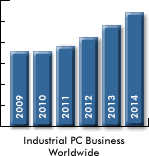
Industrial PC market driven by technological possibilities
February 24, 2010
By Manufacturing AUTOMATION
 The market for Industrial PCs is driven by an increasing rate of technological advancements in hardware and software. This includes the Atom processor, increased computing power, increased ruggedness, and also failsafe industrial PCs. The market had enjoyed high growth rates until the economic crisis. The industrial PC market structure is fragmented, with no dominant player on a regional or global level. While industrial PC technology itself has matured, new applications and requirements will enable differentiation through hardware and software.
The market for Industrial PCs is driven by an increasing rate of technological advancements in hardware and software. This includes the Atom processor, increased computing power, increased ruggedness, and also failsafe industrial PCs. The market had enjoyed high growth rates until the economic crisis. The industrial PC market structure is fragmented, with no dominant player on a regional or global level. While industrial PC technology itself has matured, new applications and requirements will enable differentiation through hardware and software.
“In 2009, the market dropped by 19 percent. Even though the recovery will start quickly, the level of the boom year 2008 will not be reached again until 2012. A major factor dampening the recovery is the constant drop in prices that is driven by user demand and a drop in intermediate good prices,” according to Analyst Florian Güldner, the principal author of ARC’s “Industrial PCs Worldwide Outlook”.
Industrial PC market will remain competitive and fragmented
The market for industrial PCs remains fragmented, the companies above two percent market share represent only 62 percent of the market. In addition to industrial PC product specialists such as Stahl HMI, the market includes focused automation suppliers like Phoenix Contact, full line automation suppliers like Siemens and Rockwell Automation, and PC-based automation suppliers like Beckhoff and B&R. Furthermore, PC specialists like Advantech and Kontron plus hundreds of Taiwanese companies supply industrial PC products either directly to the market or to other industrial PC suppliers.
One of the most important topics discussed in the market is the build vs. buy decision. Depth of production varies greatly between suppliers. Many companies use boards from Taiwan in their industrial PCs or brand label industrial PCs.
The Atom processer will boost business
Various trends within the industrial PC market will affect future growth but Intel’s Atom processor will have the most influence. The Atom processor provides up to 2 GHz with low thermal design power. This offers various possibilities to end users and machine builders. First, the low-cost, low-power Atom enables low-CPU power industrial PCs at a low price and with low energy consumption and low heat. Size-independent computing power also makes new form factors possible such as flatter panel PCs that are more easily integrated into machines and small wide screen panel PCs.
www.arcweb.com
{nomultithumb}
Advertisement
- Grain-processing equipment maker designs using digital prototyping
- Changing attitudes: Switch your mindset and drop the excuses